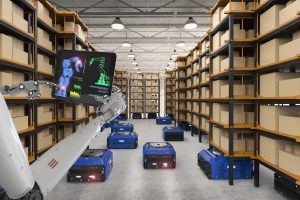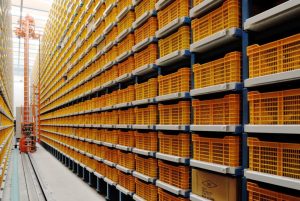The landscape in warehousing due to automation is shifting and will be very different at the end of the next decade, it feels like we are standing on the cusp of a transformation as seen in manufacturing 20-30 years ago. Having said that, Automation is having a transformational impact on Retail Distribution. The article below will evaluate the impact from various perspectives – efficiency, labour, cost per unit, and potential payback. We will also look at some of the most popular solutions in the Retail sector.
Efficiency
- Goods to Person (G2P) supported by ASRS (Automated Storage and Retrieval System) help reduce the walking element of the picking process and can help increase pick productivity by 3-4 times vs manual
- Health and safety improvements achieved through more ergonomic solutions – equipment such as robotic palletisers take away an extremely strenuous and manual role
- Goods to person workstations reduce the strain on operatives through reduced lifting, walking, twisting and bending.
- Improved accuracy, presentation and flexibility of e-com fulfilment
- Better accuracy in picking and storage, consistent presentation standards in packing and enables later next day order cut-offs
Labour requirements
- Depending on the efficiency of the base solution,direct labour can be reduced by as much as 60%. Manual jobs, such as picking, become less physically demanding due to reduced walking and improved ergonomics of the workstations, contributing to fewer health and safety issues
There is a shift towards higher skilled roles in the operation including order control, systems maintenance and continuous improvement. Managerial roles become even more critical as they need to proactively plan and utilise data to optimise the flow of volume to operate at the designed capacity of the solution. The change of skills and culture required shouldn’t be underestimated and if not right, can really impact the implementation and ongoing performance of the operation
Cost per unit and payback
- Automation helps lower cost of picking in an eCom fulfilment environment (online order fulfilment can be 5 times costlier in a manual warehouse)
- Denser storage formats leads to reduced rent and rates
- Increased productivity can help reduce the labour requirements, thus reducing cost per unit
Potential Payback
- The initial investment can be recovered in just a few years in some cases through the elimination or reduction of operatives performing warehouse tasks. The tasks which are more labour intensive are typical targets for automation e.g. picking
- The ability to generate a payback is dependent on several other factors including local wage rates and cost of land, existing productivities and labour availability.
- Competition for labour, particularly on Black Friday is so high that through fears of not being able to find adequate resource, automation becomes almost a necessity.
Commonly implemented solutions
Clients that our team have worked with are typically looking for automation to help their operations manage the channel shift to online fulfilment, especially with the advent of shopping events like Black Friday.
ASRS and G2P solutions are well established automation technologies in the retail sector but we have seen significant growth in the use of Pocket Sortation. Where Dürkopp (now owned by Knapp) were the only major player in the market, most automation integrators have now developed their own product to capitalise on this growth. Pocket sortation has two primary benefits, firstly enabling a transition from order picking to the more efficient batch picking, and it can be bolted onto both manual and automated picking solutions.
With the importance of single piece picking in eCommerce, it will be some time before we see ultra-automated warehouses, as we do in grocery. The volumes involved make distributing as cases more viable and are easier to handle with automation than a loose shirt or book. The single piece picking technology is improving and there are examples of Kuka and Kion robots using suction, AI and machine learning. This technology is still in its infancy but we are expecting to see a higher uptake over the next five years as it becomes more sophisticated.
We are seeing increased interest in AMR (Autonomous Mobile Robot) solutions over the last 12 months. They offer a lower initial investment and are particularly attractive when clients are looking for a scalable solution, or they need to retrofit to a brownfield site with low eaves. AMRs can be designed to act as an ASRS, support a zone pick solution or even sort parcels.
Our team have also seen great interest in automating the post-pick processes of packing and sortation. Packing is another highly labour-intensive process and retailers see this as another opportunity by deploying Auto Bagging machines (e.g. BVM) or auto-carton erection and closing solutions (e.g. B+). Sortation automation predominantly drives service by enabling later order cut-off times and we typically design traditional sorters (e.g. cross-belt or tilt-tray) but we have seen interesting applications of COBOTs for sorting and palletising parcels at the end of conveyor spurs being trialled.
Implementation
Implementation periods for most automated solutions can take several months and they cannot interfere with the operation during the peak trading period, now lasting from October to December and into the January sale. This places a significant constraint around the deployment of automation and can extend automation into phases over multiple years, potentially delaying the payback of the programme.
Even with a live operation, the development horizon can still be two years out to learn the lessons of the previous peak, design the expansion, manufacture and commission a large-scale solution. However, it is worth noting that certain standalone equipment (e.g. packaging machines, conveyors) can be implemented in a short timescale even if they are part of a larger programme.
Closing remarks
Automation generally reduces the flexibility of the operation and it is important to get the design right so that it can cope under a range of scenarios including volume growth, changes to seasonal profiles, expanding product ranges or changing order profiles. Retailers undergoing rapid growth need to develop a clear expansion path so that the automated solution can grow in-line with the business.
As the costs and flexibility of automation improve, the use will be more prevalent, however complex and small the operation. Understanding when and how to surf this technology wave will be the challenge for most businesses who have not already heavily invested in this technology.
Note: Part of this article was extracted and used in the February 2020 issue of Logistics Manager (Shifting Sands by Michelle Mooney; https://flickread.com/edition/html/5e32a844d916c#43)



